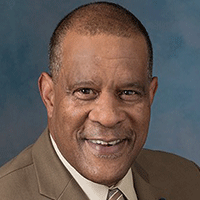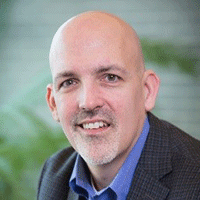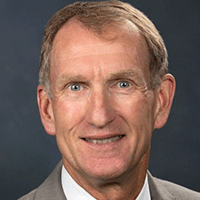Monday, September 12
8:00AM – 9:20 AM
Salons I & II, First Floor

James Hubbard, Jr., PhD
Texas A&M University
College Station, TX
Keynote Title: The Smart Structure of the Mind
Abstract: We present our most recent research in the development of a Modal Approach to the Space Time Dynamics of Cognitive Biomarkers. More specifically we apply well known "black box" output only system identification techniques to the biomarker of electroencephalogram (EEG) data. The result is a Linear Time Invariant model that admits brain wave modes of human cognitive states. The weak non-linearities and stochasticity present in the data is accommodated using an adaptive feedback scheme that adjust the model in near real-time to yield less than 1 % error with the concomitant data stream. The brain wave "modes" are linearly independent and can be likened to the keys on a piano. Weighted linear combinations can produce "chords" which can be combined to produce music and reveal the symphony of the brain. The space-time modal patterns of the brain have the potential for widespread application in the diagnosis of Alzheimer’s disease, dementia, seizures, human emotions, and the like.
Biography: James E. Hubbard, Jr., Ph. D is the Oscar S. Wyatt, Jr. Chair I professor at the Texas A&M University. He is internationally known for control of adaptive structures, and spatially distributed systems for the real-time control. He is widely viewed as a founding father of the field of Smart Structures. He is the recipient of the SPIE Lifetime Achievement Award, the SPIE Innovative Product of the Year Award, and is a Permanent Fellow of the Hagler Institute for Advanced Studies. He holds 24 patents and is the founder of 4 companies. He has published 4 books and more than 100 technical articles in peer reviewed journals. Hubbard is a Fellow of the AIAA, SPIE, ASME and a member of the National Academy of Engineering, The Academy of Medicine, Engineering and Science of Texas and the Virginia Academy of Science, Engineering and Medicine.
Tuesday, September 13
12:10PM – 1:40PM
Alexandria Ballroom, Third Floor

Paul E. Krajewski, Ph. D
General Motors Global Research and Development Center
Warren, MI
Keynote Title: Automotive Unobtanium: Material Challenges for the Future of Transportation
Abstract: The future of ground transportation promises significant changes to how vehicles travel, how they are propelled, and how customers experience the trip. Materials are the common enabler for this future, with the ability to impact autonomous driving, electrification, cabin experience and connectivity while providing superior performance and sustainable, green vehicles. This talk will first provide a vision for the future of automobiles and then identify key challenges in each of these areas including materials for batteries, sensors, displays, structures, and a variety of interior systems. The goal is to provide targets for the materials research community to help drive the development of these enabling materials.
Biography: Dr. Paul E. Krajewski is the Director of the Vehicle Systems Research Lab at the General Motors Global Research and Development Center. His laboratory is responsible for R&D in a variety of areas including Interior and Safety Systems, Autonomous Driving, Connectivity, User Experience, Cybersecurity, Displays, and Electrical Architecture. Paul also represents GM as the USCAR Leadership Group Director, as a JOG member for USDRIVE, and as the Technical Director for HRL. Dr. Krajewski is a global expert in vehicle lightweighting and lightweight materials. He received his Bachelor’s and Doctorate in Materials Science and Engineering from the University of Michigan. Dr. Krajewski has over 75 publications and has been awarded 54 US Patents. He has been recognized by Fortune Magazine (40 under 40) and MIT's Technology Review (TR100) as a leading innovator and is a Fellow of ASM International. He was inducted into the National Academy of Engineering in 2020. Paul has also published three children's STEM / STEAM books entitled "What's In Your Car", "What's In Your Body", and "What's In Your Plane".
Wednesday, September 14
8:00AM – 9:20 AM
Salons I & II, First Floor

Charles R. (Chuck) Farrar, Ph. D., PE
The Engineering Institute
Los Alamos National Laboratory
Los Alamos, NM
Biography: Chuck Farrar is currently the leader of Los Alamos National Laboratory’s (LANL) Engineering Institute, a research and education collaboration between LANL and the Univ. of California San Diego's (UCSD) Jacobs School of Eng. His research interests focus on developing integrated hardware and software solutions to structural health monitoring (SHM) and damage prognosis problems. The results of this research have been documented in many journal publications, conference proceedings and a book entitled Structural Health Monitoring A Machine Learning Perspective. Each year he teaches a graduate course on SHM for UCSD. Additional professional activities include the development of a structural health monitoring short course that has been offered more than 45 times to industry and government agencies in Asia, Australia, Europe and the U.S. He is the founder of the Los Alamos Dynamics Summer School (now in its 23rd year) and he is a co-developer of the Los Alamos Judicial Science School (now in its 10th year). In 2012 he was elected as a Fellow of Los Alamos National Laboratory. He is also a Fellow of the American Society of Mechanical Engineers, the American Society of Civil Engineers, and the Society for Experimental Mechanics.